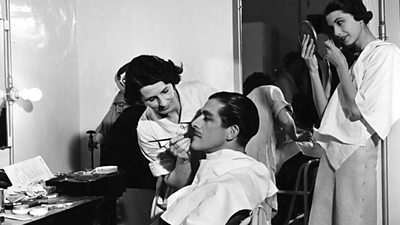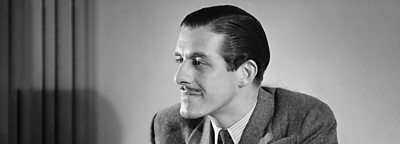The first live programme ever transmitted was Here's Looking At You, a variety show hastily assembled for RadiOlympia in August 1936. It was performed twice a day for ten days - total programme budget £300 - and featured The Three Admirals (singers from the revue Anything Goes ); Miss Lutie and her Wonder Horse Pogo (fresh from the London Pavilion); tap dancers Carol Chilton and Maceo Thomas; and singer Helen McKay.
The first programme following the official opening on 2 November 1936 was a bulletin of British Movietone News. Other programmes transmitted on that day included variety pieces and the first TV documentary, Television Comes to London.
It was shot by Bill Barbrook, the 'film assistant', and showed activity behind the scenes in the year running up to the launch - including footage of the mast being erected on the south east tower at Alexandra Palace. It was edited down to 15 minutes, set to an excerpt from Dvorak's New World Symphony, and transmitted through a telecine machine.
But the big live offering of that first night was Picture Page - a visual version of Radio's In Town Tonight. It was billed as a 'magazine of topical and general interest', a talk show with a quirky, faked element of viewer participation. Joan Miller would introduce guests from a telephone switchboard, pretending to receive calls.
'大象传媒 Television. This is the switchboard of Picture Page . You want to see who? Miss Kay Stammers? Just one moment, Miss Stammers is coming into the studio now. You're through, you're looking at Miss Kay Stammers, the celebrated tennis player.'
Thus television's first catch phrase, 'You're through, you're looking at.' was born.
Like everyone else working in the new medium, Picture Page interviewer Leslie Mitchell found himself on a steep learning curve. It soon became apparent that scripted interviews did not work. He began by mixing up his questions, to draw more spontaneity from his guests who otherwise tried woodenly to follow what had been rehearsed. But within a few months of the launch scripts were abandoned altogether.
He was also frustrated by a 大象传媒 rule that presenters should be anonymous. He was identified only as 'the male announcer', until he undermined the system by encouraging interviewees to refer to him by name.
'Nobody could stop them, and I became known as Mr Mitchell,' he recalled. 'I'd got an identity.'

Radio Times November 1936
-
The Television programme supplement from the first week of the regular television service.
